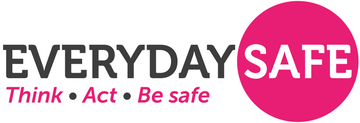Safety in action
Find out how people are talking about safety and putting good safety into practice across the University
Professor Martin Maiden, co-chair of the Safety Executive Group, talks about EveryDaySafe:
How you can apply the EveryDaySafe values - success, responsibility, action, learning and leadership - in your daily work (April 2023)
Applying EveryDaySafe values in your daily work (Subtitled)
Why a sense of community is at the heart of the EveryDaySafe programme (October 2022)
If you'd like to share your thoughts on safety in future voxpops contact the project team. We'd love to hear from you.
Reflecting on the outcome of the University's Health & Safety Review - towards a new safety culture (May 2022)
Dr Chris Williams, University Safety Officer, provides a short, fun, informal explanation of the four types of safety signs you can find in different spaces around the University.
Know your safety signs (Subtitled)
Caroline Taylor, University Fire Officer, and Betty Maciorowska, Assistant University Fire Officer, provide simple fire safety dos and don'ts that all University members should follow.
Be Fire Aware: fire safety dos and don'ts
Have a go at our latest EveryDaySafe quiz, which will test your knowledge on fire prevention, actions to take during a fire, and general fire safety trivia:
Also, why not protect your colleagues in the event of a fire and volunteer to be a fire warden? Find out more about what this entails, and how it will benefit you.
Since launching, staff across the University have positively engaged in the EveryDaySafe programme. It's important to celebrate the success stories of those safety citizens who are truly embodying the action-oriented culture.
A collaborative ‘One UAS’ team, comprising Estates Services and the Safety Office, has been formed to improve fire safety across the University. The initiative aligns with the heightened focus on fire safety in buildings following the Grenfell tragedy in 2017.
The Building Safety Act, which came into effect earlier in 2024, emphasises high-risk buildings. Although Oxford does not have buildings classified as high-risk under the legislation, the University's estate does include buildings that are of national importance due to their cultural and scientific nature.
Over time, many University buildings have undergone changes, such as the addition of air-conditioning systems and data cabling to support modern equipment and controlled environments. These modifications, coupled with evolving fire safety requirements, mean it is necessary to review if there has been drift between the original design and where the building is now.

To address these challenges, the Oxford FUSE (Fire Updates and Safety Enhancements) programme was launched following a successful pilot during 2023 and 2024. The pilot highlighted a need to improve the University's fire risk assessments and the fire resilience of its buildings. The FUSE programme includes a thorough review of paper-based risk assessments, physical works, and operational practices.
Positive stakeholder engagement and a strong support from the University governance structure, including the Safety Executive Group, have provided a solid foundation for the FUSE programme's activities, which will continue throughout 2025 and 2026.
In November 2024, the University joined forces with Oxfordshire County Council, Thames Valley Police and other local partners to host the Vision Zero road safety event on Broad Street. Fazil Jebin, Engagement Officer at Environmental Sustainability, told us about the event:
Vision Zero is an initiative aiming to eliminate all traffic fatalities and severe injuries by 2050. The University has embraced this goal with a campaign to ensure safe and sustainable travel, encouraging modes of transport such as cycling, walking and scootering, often in combination with public transport.
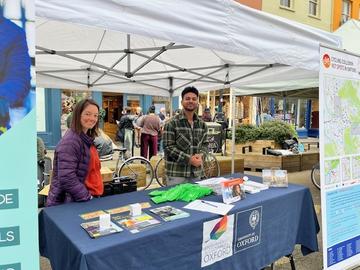
Credit: Faz Thottungal Habeeb
The event focused on improving road safety for the more vulnerable users, such as cyclists, pedestrians and scooter riders, and drew an enthusiastic turnout from students, staff and local residents. Attendees had access to resources designed to enhance their safety and were informed about initiatives encouraging safer practices among motorists, including heavy goods vehicle (HGV) drivers.
Participants had the opportunity to register their bikes with Thames Valley Police to deter theft and receive practical advice from University Security Services. The Environmental Sustainability Team introduced visitors to an incident hotspot map and offered tips on safer cycling routes. Cyclists were also invited to take part in the University’s free cycle training scheme, aimed at improving their confidence and skills in navigating city traffic.
A highlight of the event was an interactive demonstration with an HGV vehicle, where visitors could experience the driver’s blind spots and learn strategies for safe interactions with these large vehicles. Thames Valley Police also promoted their “Be Bright, Be Seen” campaign, underscoring the importance of proper lighting and visibility for cyclists.
Support from Oxford’s innovative research
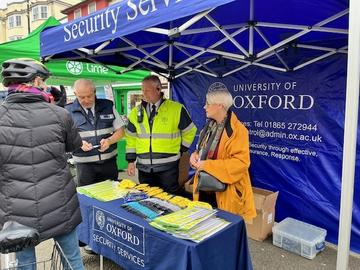
Credit: Faz Thottungal Habeeb
The Oxford Robotics Institute joined the event and showcased its cutting-edge RobotCycle project, which applies robotic technology to study how cycling infrastructure influences the behaviour and safety of road users. The demonstration revealed how the device collects real-world data, analyses user interactions and categorises roadways by safety levels, providing valuable insights for urban planning and infrastructure improvement.
Dr David Prout, the University’s Pro-Vice-Chancellor for Planning and Resource Allocation - and a cyclist - emphasised the importance of collaborative efforts to improve road safety:
'The cyclists, scooter users, and pedestrians being hurt on the roads are our friends, colleagues, students, and family members; every death or injury is a tragedy that could and should have been prevented.
Our goal is streets that are truly safe for everyone and to reach it we need the whole community to work together, from individuals to councils, business, universities and public services. We hope this event makes a real difference in keeping people out of harm’s way, no matter how they choose to get around Oxford.'
The Vision Zero event served as a reminder of the shared responsibility to create safer, more sustainable streets. Learn more about Vision Zero on the Travel website.
Safety officers are invited to contact the travel team for more information and resources.
During summer 2024, the University Fire Team hosted a small delegation from the British Museum. The visiting representatives included the Director of Estates and Capital Projects, Head of Capital Development, Head of Environment Health and Safety (EHS), Operations and Policy Manager EHS, Fire Safety Manager, and Head of Facilities Management and Workplace Services..
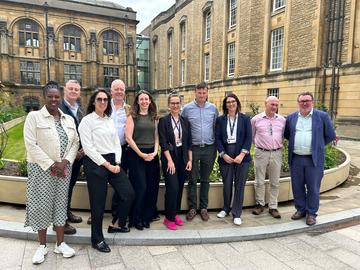
The purpose of the visit was to facilitate an exchange of experiences and best practices between the two institutions. The
delegation was taken on a guided tour of the Museum of Natural History and Radcliffe Camera. Caroline Taylor, University Fire Officer, told us:
'These visits provide a valuable opportunity to discuss the unique challenges associated with fire safety, estate management, and capital development in historic and high-traffic sites.
The discussions focused on the complexities of maintaining safety and operational standards while preserving the historical and cultural significance of such sites. The exchange of insights between the University and British Museum teams is expected to enhance the approaches both institutions take in managing their respective responsibilities, particularly in the areas of fire safety, environmental health, and the management of estates and capital projects.
This collaboration with the British Museum also highlights the importance of inter-institutional learning and our commitment to maintaining high standards in managing cultural and academic institutions.'
In June 2024, Matthew Brack, Operations Manager for the Department of Politics and International Relations (DPIR), and Millie Oates, Business Continuity and Projects Manager at Oxford School of Global & Area Studies (OSGA), held a joint roundtable to gather expert views on departmental responses to major overseas incidents. The pair told us their key learnings from this exercise:
Why did we arrange a joint exercise?
Both of us were keen to improve our departmental process in this important, high-risk area. We reached out to Neil Carveth, our Divisional Safety Officer, who introduced us to each other. We quickly realized that our departments shared a similar risk profile, faced comparable travel safety challenges, and even shared several academic staff. Collaborating seemed the best approach to address these issues collectively, allowing us to share skills and learn from each other’s incident experiences.
How did we arrange it?
We designed the exercise as a ‘roundtable’ discussion, aiming to foster an open and engaging dialogue with experts from across the University. We reached out to key stakeholders from both our departments and the wider University, and were delighted they all agreed to take part. We circulated formal invitations along with real-word scenarios, giving participants time to reflect on the issues and come prepared for a productive session.
What did we learn?
The exercise was a success, with high levels of engagement and valuable feedback. It highlighted the benefits of collaborating and the effectiveness of gathering everyone in the same room, showing that this model is worth repeating.
The roundtable provided a valuable opportunity to assess our process with our users, exploring how it performed (and where it fell short) across different scenarios. This discussion brought to light several risks, such as unclear procedures, that we hadn't fully recognised before. With this newfound awareness and user engagement, we can now develop a more resilient and transparent process that addresses these risks. This, in turn, will enable us to continuously improve and maintain the resilience of our business continuity efforts.
All attendees agreed to form an informal working group to support follow-up actions, including a tabletop exercise to test the draft guidance developed after the roundtable. We hope to share our final guidance widely across the University.
The Oxford School of Global & Area Studies (OSGA) has been on a long journey to improve safety culture. Since becoming Business Continuity and Projects Manager at the start of 2024, Millie Oates, who was previously departmental safety officer (DSO), has witnessed the department grow in its efforts to improve safety standards.

Millie told us:
During my time as DSO, I worked with four heads of department, all of whom were very engaged with safety culture and supportive of improving standards where we could. I'm immensely proud of what my department has achieved and this is in thanks to everyone involved, from both within my department and the wider University.
Our most recent annual H&S inspection reports have a low number of actions which shows just how far the department has come. We've developed clearer processes, upgraded physical systems (including our emergency lights and fire detectors) and managed incidents (including floods).

Head of Department Professor Paul Chaisty added:
Since becoming Head of School, I have come to appreciate the importance of aiming for, and supporting, improved safety standards and culture. It has become integral to our thinking about the development of the School, which historically has been organised around Centres and Institutes with their own distinct approaches. By striving for consistency we have identified many other key priorities, which have proved beneficial in shaping our overall strategy.
Millie shared her key messages for success and offered practical tips for other departments to reap the same rewards.
‘My key message on how to do this journey is simple: talk about safety.
- All of us have a responsibility and need to be enabled to discuss safety openly and honestly. What do your staff and students feel is working well? What are their concerns? How are we progressing with the actions in our annual H&S inspection reports?
- Think about the roles within your team. There will be roles with direct safety responsibility (such as facilities managers), but also roles which might be end users or observers of safety (event managers, academic admins and HR). What does safety mean to all your team roles? Do they feel sufficiently trained and given opportunities to discuss safety if needed? If they feel safety is a concern, a barrier, or something they have no time for, why is this the case and how can it be addressed?
- Always involve senior management and ensure communication is linked up. We have H&S as standing items on several committees, all of which feed into our DSAC (Departmental Safety Advisory Committee). How does communication flow in your team?
-
Develop standards with consideration for different roles and accessibility needs. I do this automatically - my background is in special educational needs support and I’ve had a lot of training on it - so consider how you can make this an automatic consideration for your team
-
What safety information is there on your staff intranet, your student Canvas website and displayed in your building? Is the information accessible, clear and engaging? Can you refresh it and promote this further in your newsletters? Do you use the EveryDaySafe resources?
- Enabling effective communications about safety will help you identify what needs to be improved. It can be daunting to work out what needs to be improved and how to do this, but it becomes easier and has so many benefits. On this journey you'll find examples of best practice – and that's something you can share with your team and leadership. I suggest managing this like a project – breaking it down into stages gives you targets to aim for and milestones to celebrate
- Read the University policies and check how you're meeting these standards – is there anything you could improve on? Identify ways to measure that these standards are working. Stats can be an effective way to give a snapshot
- Safety is a live matter. It always needs reviewing because things change. These changes might not be safety driven but it’s important to bring safety into the discussion. If we’re planning to refurbish a student study space, can we use the opportunity to refresh safety posters and engage students on how to report building faults? If we’re planning a new process for academic visitor applications, can we embed a process trigger for safety inductions?
- You're not alone – there's a thriving Safety Network at the University who can share knowledge and best practice. Make use of the Safety Network, the Safety Office, the EveryDaySafe programme, your divisional safety officer and the SHEOx Teams network. Consider Professional Services Together and the Focus team. I invested time to understand dealing with change culture (People and Organisational Development (POD) has courses on managing change and working with others) and continuous improvement (use the Focus Toolkit).
- Be realistic. Remember that safety should be reasonably practical. You can reduce risks but cannot eliminate all risks. If incidents happen then a good safety culture gives you the framework to respond and learn for the future.'
Millie added:
In my view, safety is essential for workplace wellbeing: a safe work environment with good safety citizens enables us all to do our jobs. I hope that sharing our journey to improve safety culture and standards will inspire others.
A compressed gas cylinder safe practice guide has been produced by Christina Foldbjerg Holdway, Chemical Safety Advisor at the Department of Materials. Having initially joined the University as a lab technician, Christina was given the task of changing the gas cylinders in an outdoor gas cage which supplied inert gas, mainly nitrogen, to equipment located in the lab.
To develop her practical understanding and confidence, Christina found YouTube videos a really helpful source of information.
As a result she’s produced this guide with the hope it will provide the practical knowledge, tools and awareness needed in order to handle gas cylinders safely. It provides guidance on planning, storage, step-by-step procedures for connecting, leak checking and disconnecting, maintenance and emergency procedures.
She added that research supervisors and lab managers may use the guide in conjunction with practical training, adding 'I, for sure, would have found it useful back then'.
View the compressed gas cylinder safe practice guide
On Wednesday 11 October 2023, two safety officers from Hong Kong visited the University. Dr May Chan and Andy Fong of the Health, Safety & Environment Office at Hong Kong University of Science & Technology were shown various areas of the University.
The tour included visits to the Robotics Laboratory in Engineering Science and the Laing O’Rourke building site of the new Stephen A Schwarzman Centre for the Humanities.
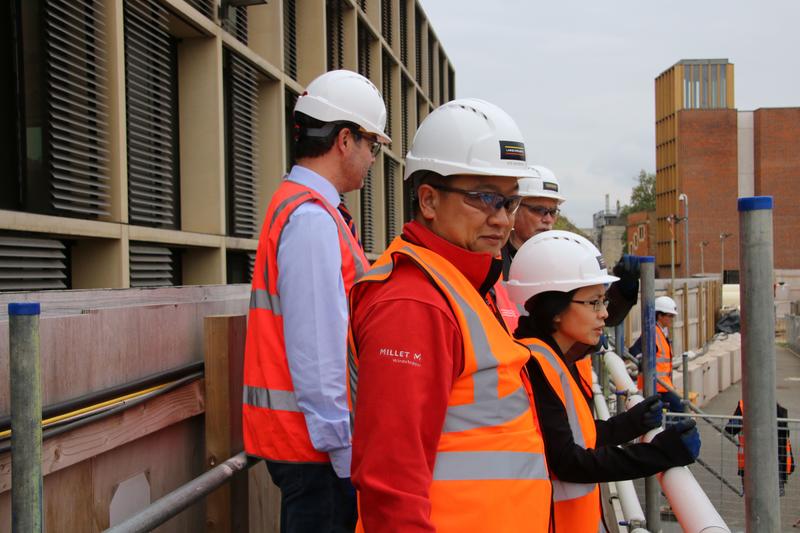
Accompanied to the various departments by Les Wright, Director of Occupational Health and Safety, along with other members of the Occupational Health & Safety Office, they were then joined by Professor Martin Maiden, Safety Executive Group co-chair, for lunch at Hertford College.
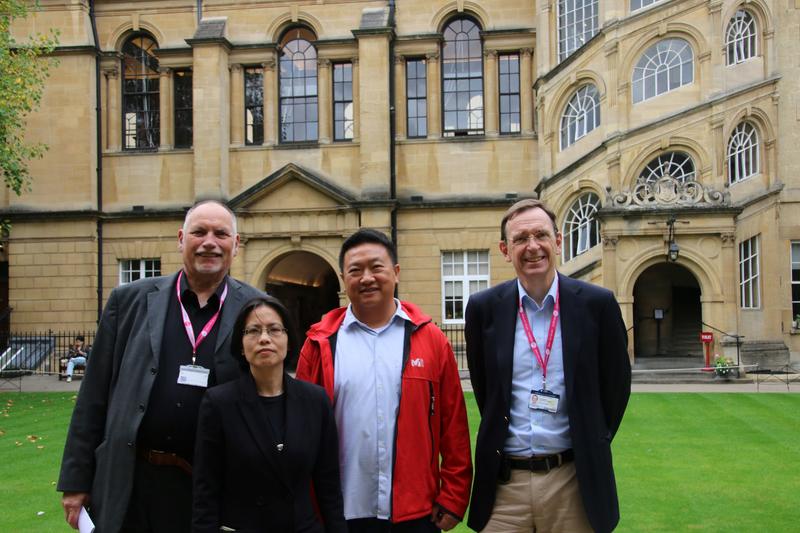
Commenting on the commonalities between the two establishments, Les Wright said: "There are many similarities between both the challenges, and the responses, at each of our respective universities. Our visitors were also due to visit the annual conference of the University Safety and Health Association (USHA), and through this and their visit to Cambridge earlier in the week they will have established a network of contacts who would be happy to continue building supporting relationships across the global health and safety community."
Elaine Anstee is Head of Imaging Services. She realised that her team’s risk assessment did not mention alternative fire escape routes from their Imaging Studio space and the need to practise them. Additionally, under normal arrangements, the team did not have this route on their ID cards – although if there was a real fire, the necessary doors would be automatically released. So she arranged for an additional door to be added to access permissions for all her staff.
They all practised using the new second route in small groups and all other staff who access the team’s studio have been informed and encouraged to do the same. Practices will now take place twice a year for all staff and the new route is highlighted on maps displayed on both exit doors.
Elaine’s team also highlighted desired improvements to training and drinking water, both of which have been acted upon:
Training
As they work in a unique space, the team felt that annual manual handling and safety awareness training should be delivered on site in the Imaging Studio.
In the summer of 2023, the local health and safety officer came to the studio and delivered the manual handling and safety awareness training in the studio. The session proved an overwhelming success, in large part due to the course being targeted at the real life work of the studio. The intention is to ask for this to be repeated every two years or if there is a significant change in staffing.
Drinking water
During hot weather – which we all experienced during summer 2022 – the team had to make long trips to other parts of the building to refill their water bottles (due to material handling regulations, only one bottle each is permitted and must be kept at the studio entrance). To avoid these disruptive and tiring expeditions, the team asked for a new water unit to be installed for use by them and other nearby teams.
The water system has since been implemented and is sited outside the image studio (see below). Additionally, a new jigsaw table was added for anyone needing a couple of minutes away from their desk. This was put in as an extension of the thought process behind the water station and for general staff wellbeing.
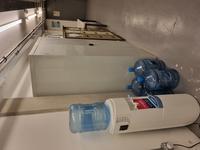
In July 2023, a fire safety audit took place at the Examination Schools. One issue that arose was the need to review the room capacity for the East School, a large hall served by a single door.
In line with modern fire safety guidance, a room with a single doorway is considered to safely accommodate a maximum of 60 people only. Until the audit, this room had been used to accommodate far more – up to 160 for exams, which raised a concern with the Enforcing Authority Inspecting Fire Officer, of Oxfordshire Fire & Rescue Service.

©OUImages/John Cairns Photography
To review these figures, a fire risk assessment was carried out. This provided a great opportunity to put the University’s updated fire risk assessment template to the ultimate test – assessing the risk to people from a fire occurring in a building that doesn’t meet modern-day standards.
After attending the supporting Further Guidance for Fire Risk Assessors course, the building’s Senior Facilities Manager was able to apply the new process. The risk assessment was not only deemed suitable and sufficient by the fire officer, but also one of the best risk assessments he had read.
The assessment’s findings are able to support an increase in the number of people that can be safely accommodated in the East School. The maximum figures vary depending on the activity taking place within, with 160 being maintained for exam conditions, 120 for teaching and lectures, 100 for conferences, and 60 for private events such as weddings where the consumption of alcohol is factored in.
This example should be used to demonstrate the importance of completing a well thought-out risk assessment. It has relieved the pressure on those responsible for allocating the event space and finding a suitable space for large cohorts.
Use the University's Fire Risk Assessment templates
The Department of Engineering Science has earned recognition at an international conference for their design of an ammonia manifold and delivery system. Li (Sam) Shen and Felix Leach presented their work at the second Symposium on Ammonia Energy conference in July 2023.
Hosted by the University of Orleans in France, it is one of the largest conferences in ammonia research society. The three-day event, which showcases more than 100 presentations, welcomes hundreds of researchers from all across the world.
The system was installed in the Thom Building at the Department of Engineering Science, under the supervision of DSO Philip Paling. The presentation, entitled An Introduction to Ammonia Spray Lab Safety and Setup, detailed the method behind building a lab from scratch for ammonia spray tests and the subsequent safety precautions taken.

Safety features included:
- Emergency safety relief valve at pre-set pressures
- Bubbling waste ammonia into water and disposal of the resulting alkaline solutions
- Ammonia and in-line pressure sensors for leakage detection
- Solenoid valve power supply interlocks with leakage detection sensors
The audience in attendance appreciated the Department’s hard work on making everyone safer. For more details of the project, a modified version of the conference presentation is available below.
For EveryDaySafe culture change to become a reality, it’s vital that departments play their part in spreading the message among their staff. Truly embodying the action-oriented approach, the Ashmolean Museum has gone above and beyond in ensuring its staff are receiving adequate, but not overwhelming, advice and guidance.
The EDS team spoke to Mike Finneran (below), Ashmolean Head of Safety and Security, to learn how they’ve made their communications so impactful. 'I decided to do it after Brian Jenkins, Head of the Safety Office, came along to one of our GLAM DSO meetings to talk about EveryDaySafe,' Mike began.
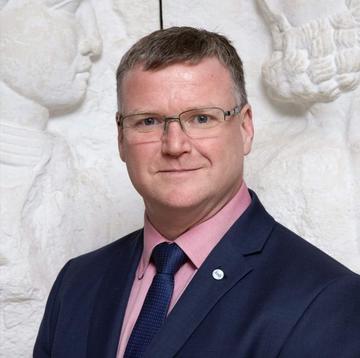
'That sparked my interest because I want to get as much information to my colleagues here as possible. Having looked at the wealth of information available on the Safety Office website I was pondering how to get the message out there in a way that would resonate with people. I decided to do a week-long campaign, using the series of five posters promoting the five EveryDaySafe values, to send out a message each day with some information about EveryDaySafe.'
This strategy proved successful, as Mike received positive feedback after day one. 'I always try and make all the information I send out quite light-hearted because health and safety is a really heavy subject otherwise – if I start quoting legislation at people they’ll turn off,' he explained.
'So I then did day two to five with a different message each day, with a different outlook on health and safety and again I was getting some really good feedback and by the time I got to day five, people were talking about it.'
However, Mike is keen for the message to be longer-term than the initial five-day campaign, and has plans to ensure the message is consistently reinforced. He continued: 'I’ll be displaying the EveryDaySafe values animation on our screen in the St Giles’ staff reception. I’ve also updated our Ashmolean intranet, and created an EveryDaySafe folder so there’s one point of contact for people to go to for information. In there, I’ve added all the EDS messages that I’ve sent as PDFs.
'And I’m looking at producing coasters with key messages like ‘be a good citizen, don’t walk by’ that we can give to all our staff at the museum.'
Mike hopes the EDS message will continue to support and improve upon the safety-conscious culture set by the museum. 'Staff accidents have gone down massively over the past few years, and I’m hoping the EDS message will help with that even more.'
Perhaps most encouragingly, Mike’s efforts have been well received by those in senior management positions. Dr Xa Sturgis, Director of the Ashmolean, has positively supported the EveryDaySafe mission, subsequently inviting Mike to promote the culture change at an all-staff meeting.
As part of his week-long campaign, Mike sought to involve other members of the leadership team too. The message from Claire Lane, Commercial Director, was: 'It [health and safety] couldn’t be more critical. It’s essential that we’re protecting ourselves, each other and our visitors and we all play a vital role. Being aware and vigilant is everyone’s responsibility – please don’t walk by – report it, sort it.'
As Mike summed up:
'The EveryDaySafe message to me is about coming to work and keeping yourself and everyone else as safe as possible and going home safely to the people that matter. Not just ignoring issues, thinking that someone else will come and deal with that, but actually having the courage and the confidence to deal with it yourself or to report it to someone who can deal with it. We are not perfect, we make mistakes, but we are committed to improvement and the EveryDaySafe message is a great reminder to help us achieve this aim.'
Hand-arm vibration (HAV) is vibration transmitted into the hands and arms from the use of hand-held power tools (such as grinders and strimmers), or through contact with materials that are vibrating, such as during cutting. Regular and frequent exposure can lead to a range of health conditions, most commonly vibration white finger (a permanent and painful numbness and tingling in the hands and arms).
In May 2021, a consultant occupational hygienist undertook a survey of the University Parks team’s exposure to, and management of, HAV. This identified that operation of most of the tools tested, over the reported usage periods, was a cause for concern. In particular, two old petrol strimmers exceeded the daily Exposure Limit Value in as little as 20 minutes.
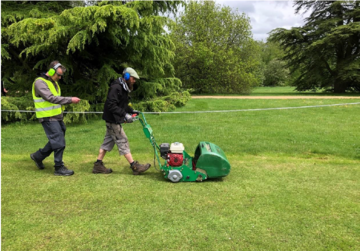
These strimmers were taken out of action immediately, and a comprehensive programme of HAVs management was embarked upon. This included equipment replacement, moving to battery-powered equipment where possible, regular equipment maintenance, work activity management, risk assessment, staff training and health surveillance.
The Safety Office developed a system of counting cards to allow dynamic tracking of exposure throughout the day using a very simple 1-10 counting system. This allowed identification of when maximum exposure was reached and work with vibrating equipment needed to cease.
The Parks Team introduced a spreadsheet to monitor the total points recorded by the counting cards each day, while weekly supervisor meetings discussed any areas of a concern. Following an extensive period of monitoring, spanning a year, it was found that levels no longer reached or approached the maximum of 10 points, resulting in supervisors being able to undertake this check less frequently. Measurements will be repeated to monitor the ongoing efficacy of the measures.

When an office manager (anonymous) in IT Services put safety on the agenda for his team meeting, it prompted some useful discussions and actions:
- Looking around their workspace they agreed to keep an eye out for and remove trip hazards
- Checking that the heater had been PAT tested (even if they are not expecting to use it)
- Realising they weren’t sure how high they were allowed to reach for books on shelves using their step stool.
The Safety Office team explains:
'Thousands of injuries a year are caused by falls when working at height – many of them associated with falls from less than 2 metres. The current Working at Height Regulations have no lower limit so even using a step stool counts. The legislation encourages a risk-based approach to work at any height where injury may result. This means selecting (and maintaining) the right item of equipment to reduce the risk of falling and taking into account the activities involved. It may be appropriate to use a low level stepladder, instead of a step stool, to prevent over-reaching and to ensure there is a third point of contact (e.g. hand-hold) from the stepladder/platform. You can find out more in our policy document, on the HSE website, or by discussing this with your departmental safety officer for advice.'
Let us know if you have a story to share about how you’ve been talking about safety in your team.
Contact us
Be Fire Aware
- Take the Be Fire Aware quiz
- Watch the fire safety dos and don'ts video
- Fire safety guidance
- Become a fire warden
Look, Learn, Act
- Understand the four types of safety signs
- Take the safety signs quiz
- Watch the Know Your Safety Signs video
EveryDaySafe Values
Related links

